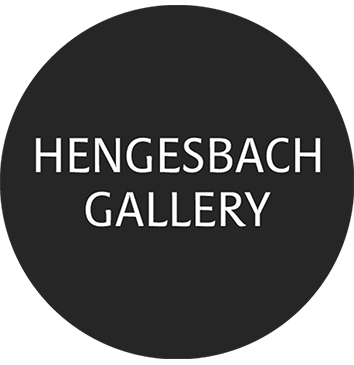Moritz Neuhoff
August 21 – November 11, 2022
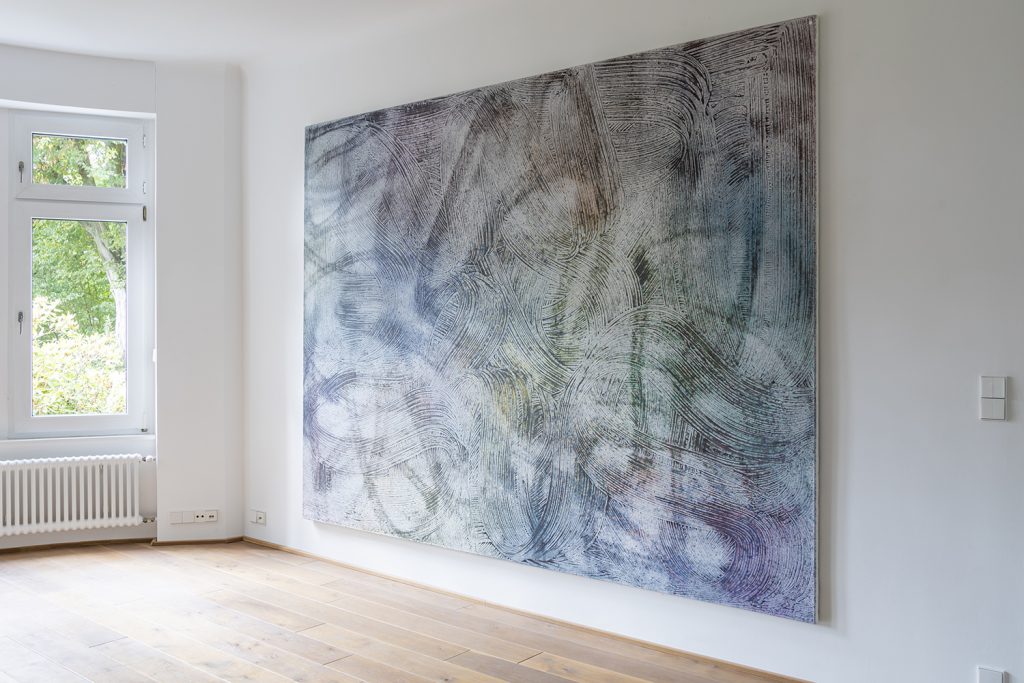
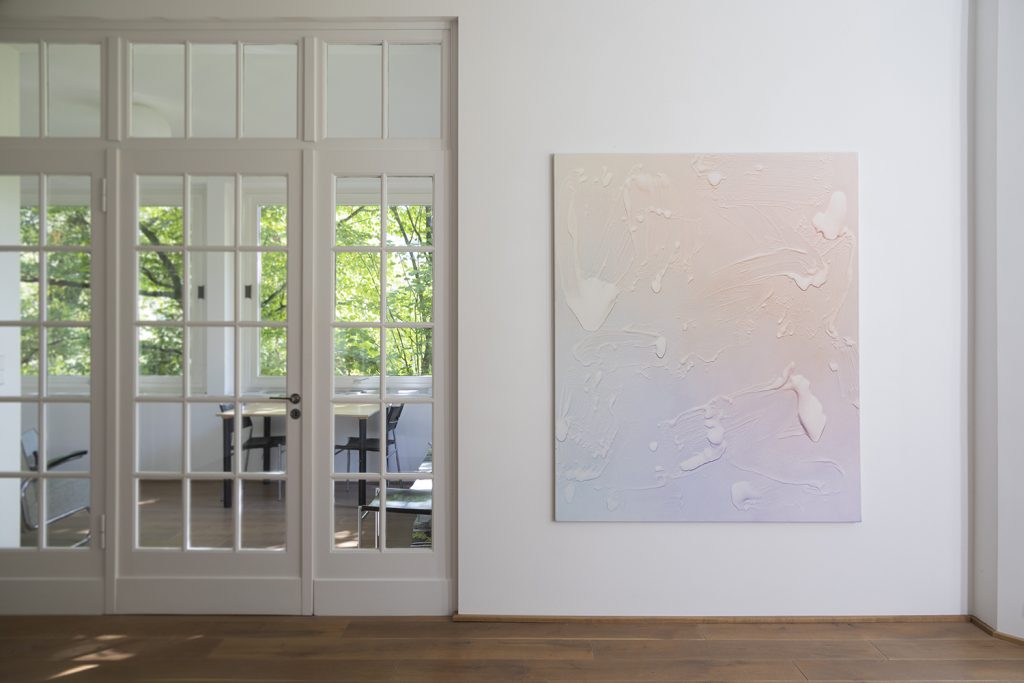
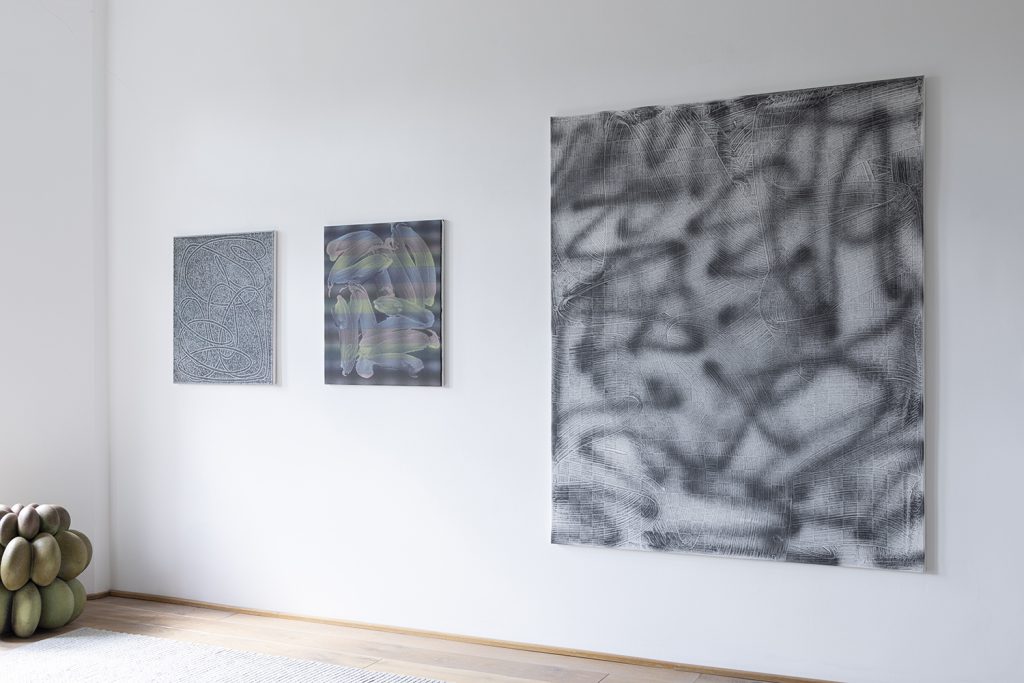
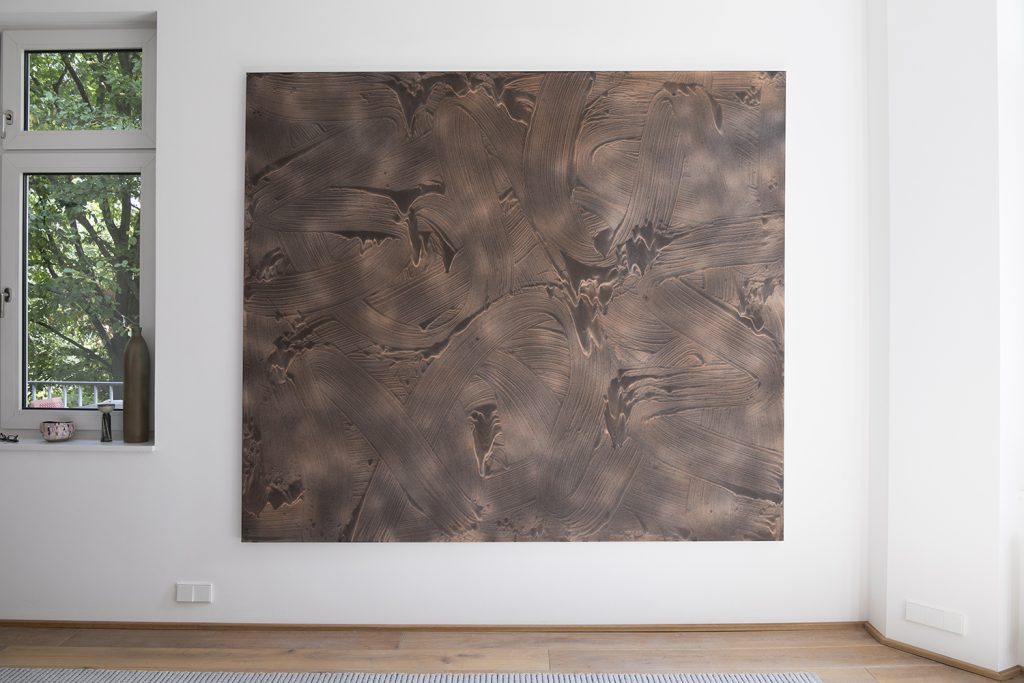
Photos: Dirk Wüstenhagen
Moritz Neuhoff’s large-scale paintings celebrate the act of painting. They exploit the full palette of painterly possibilities, leading the viewer into the astonishing diversity of visual richness that painting has offered over the last eighty years. This richness stems from Neuhoff’s diverse painterly movements, his layering of painterly strata, and a careful contrast of colors. He works with subtleties, with hints, with fine traces, which requires precise viewing.
His paintings incorporate experiences we recognize from our dealings with our media environment. Smartphones and laptops seem to present our world realistically, yet their different light, artificial colors, immaterial spaces, and layered levels are embraced by Neuhoff. How can electronically generated image properties be simulated or transferred onto huge canvases with brushes and paint? Neuhoff has found astonishing solutions to this, which will be discussed in more detail.
At the same time, he engages with the fundamental question of painting: how can something different be hidden behind a visual appearance? In Neuhoff’s images, there are no figurative scenes with embedded meaning; rather, seemingly meaningless gestures of painting articulate themselves, transforming so that the painting becomes a veil that rises and falls, depending on whether something is hidden or revealed.
The paintings operate on the assurance that painting is precisely what it can be in the physical process of applying paint, yet they radically undermine this process. Upon closer inspection, the supposed materialities dissolve. All defining factors of painting are drawn into this dialectical process of real physicality and virtual appearance: light, colors, movement, line, space, and spatiality.
The light in his paintings is informed by contemporary experiences with screens, where light emerges intangibly from behind or within the pictorial elements and breaks sharply at material edges. Neuhoff’s paintings harbor an iridescent, immaterial light that emerges from the painterly surroundings as diffuse, seemingly mobile radiation without sharply delineating itself. It can appear as shimmering bright radiation from a dark base, as a glow within the darker paint movements from a light base, or as a flickering or floating glide within the color.
The colors are restrained, lurking in latency and only fully visible upon careful observation, not derived from nature, nor related to the colors of our product world with their artificial surfaces. They convey the impression of simulating themselves. They constantly vary in tone, interwoven with unreal light. Some of his paintings appear monochrome with grey as the base tone, from which colors slowly emerge. In others, the color lifts from the background upwards, not as a single color value, but often in a proportioned mesh of other colors. This network, viewed from a distance, presents itself as an engagement with spectrality, involving the spread of the full palette of colors in their internal cohesion, which enhances the special light in the paintings. Neuhoff creates various brightness zones and operates with dark body shadows, which he layers in translucent layers. This creates a spatiality that is further intensified by a dialogue between sharpness and blurriness. The spaces shift without leading to a clear, tangible layering of depth. It is never quite clear what constitutes the foreground or background space, giving the space a fictional character.
The paintings depict a world in motion, articulated through thick or thin lines. These lines can radiate outward, nearly dissolve, and transition the movement into the diffuse. The background can open up and absorb or engulf the lines like a moving sea. One can identify with the large brush swirls and interpret them as one’s own unpredictable life twists or relate them to one’s environment with its uncontrollable forces and directions of social life.
Neuhoff sets different dynamics of movement against each other. He further amplifies the accompanying uncertainty by contrasting different scales. Thus, the movements can be interpreted as magnifications of something under a microscope or as minimizations of something seen from afar. They seem to have no beginning, start abruptly, and do not seem to be related to a center that assigns them an organizing reference point. They can be interpreted as emerging from the unfathomable, chaotic context of urban graffiti or seen as interstellar complex energy phenomena, where between a perceivable location of movement and a chaotic thicket, the boundary disappears. Simultaneously, Neuhoff forces a contrast between free movement and movement confined or frozen in grids.
The emergence of the virtual also touches the overall material appearance. From a distance, one might think the dark inner shadows suggest a significant material application, but up close, the flatness of the paintings becomes apparent. The difference between material paint application and printed surface seems to be rendered absurd by Neuhoff’s painting. Painting dives into the mimicry of media qualities. Thus, in the perfection of deception, one no longer believes in a painterly authorship but in a digital print or in an objective-seeming photography of unknown origin with a mysterious subject.
The oscillation between subjectivity and objectivity of the movements also generates uncertainties in the interpretation of the forms. Thus, a dynamic gesture repeatedly stands out against neutralizing grid forms or against grainy sandy image grounds. At the same time, in its course, the highly artificial painting gesture can disintegrate into fluid bubble forms, presenting it as the result of a natural material fate. Indeed, the paintings continually oscillate between an overflowing materiality, possibilities based on matter, and a decay of materiality, material inaccessibilities, or a negation of material. Such a swell of contradictory processes can be interpreted as visual insights into scientifically explored micro or macro worlds, as an excess of our societal material production, as expressions of exuberant youth culture, or as a self-representation of painting.
As Neuhoff consistently cites from the complex history of painting employing various strategies of paint application and utilizes its entire register, yet simultaneously dematerializes their appearance, one might also speak of a reflective meta-painting. It possesses all elements of painting and at the same time withdraws its own painting from a real semblance. The image shows its own creation and simultaneously exposes it as an illusion.
However, this unmasking is only one side of the dialectic of appearance. It is also accompanied by a deeper sensual perception experience: the immersion into a world of veils. Seeing seems to cling to something. As it attempts to grasp this, something else makes itself known from the background. As seeing tries to penetrate this, it loses its initial point of reference and also fails to capture the new. Seeing eludes its own foundation in its wandering: with Neuhoff, the image becomes a veil. In the dialog of sharpness and blurriness, of movements that cannot be grasped because they emerge from the depth of space and disappear into it again or are lost in the color mixture of the surface, which atomizes to the edges, dissolves into its background or merges with it, there is a constant opening and closing of the picture. Neuhoff’s paintings convey the experience of visual transreality.
Neuhoff’s individual painterly gestures are not aimed at a compositional order, at a fixable context; they appear arbitrary as an act of constant, senseless calling for freedom. In the collective viewing of the individual gestures, the question of the meaning of the painterly structure arises. Paradoxically, however, the individual gestures in the paintings do not remain as isolated static placements. Through the manner of their visual self-negation, they create a coherence without an identifiable compositional structure. The gestures move in a serene juggling of meaninglessness, of thicket, of chaos, condensing in the open depth movements of the images into veils that create a constantly shifting pictorial space of advancing and retreating, and it is these intangible image spaces that make us aware of the elusiveness of freedom, which seems to fall from the sky for us humans.
Rolf Hengesbach
A catalog has been published for the exhibition.
